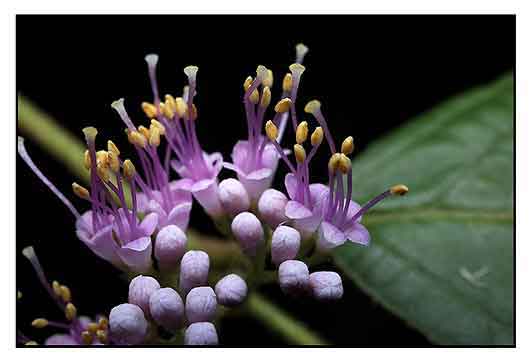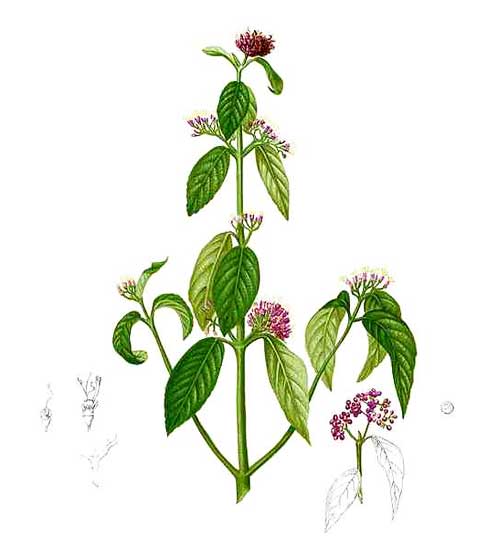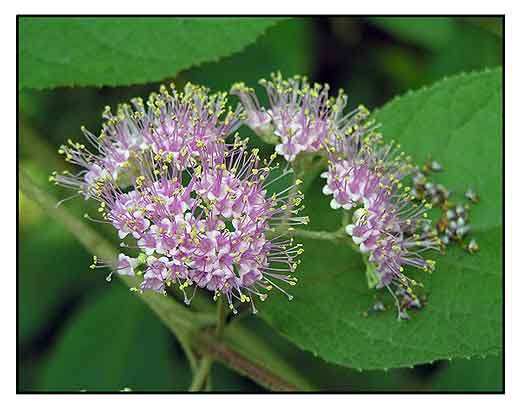 Etymology Etymology
- Genus name Callicarpa derives from the Greek word 'kalli' meaning beautiful and "karpos" meaning fruit. (15)
- Species names 'pedunculatus, a, um,' is Latin, meaing 'equipped with peduncle', referring to the peduncle of inflorescences longer than the petioles. (21)
Botany
Palis is a shrub growing 1 to 3 meters high. Younger plant parts are thinly or densely covered with short, stellately arranged, brownish or pale hairs. Leaves are ovate-lanceolate to oblong-lanceolate, 5 to 15 centimeters long, 2.5 to 6 centimeters wide, with a long slender, pointed tip and pointed to blunt base. Lowers surfaces of the leaves are densely covered with stellate hairs, and with numerous, small, waxy, yellow glands. Cymes are axillary, short-stalked, and 2 to 4 centimeters long. Flowers are pale purplish or lavender, and about 3 millimeters long. Fruit is a berry, fleshy, rounded, pale lavender, and 4 to 5 millimeters in diameter.
 Distribution Distribution
- Native to the Philippines.
-
Throughout the Philippines in thickets and secondary forests at low and medium altitudes.
- Sometimes cultivated as an ornamental.
- Also native to Assam, Bismark Archipelago, China, Hainan, Himalaya, Laos, Lesser Sunda Is., Maluku, Myanmar, Nansei-shoto, New Guinea, New South Wales, Queensland, Solomon Is., Taiwan, Thailand, Vietnam. (8)
Constituents
- Ethanol extract yielded four new iridoid glycosides, 6-O -benzoylphlorigidoside B, 6-O-trans-cinna- moylphlorigidoside B, 6-O-trans-p-coumaroylshanzhiside methyl ester, and 4'- O-trans-p-coumaroylmussaenoside together with known constituents, 6b-hydroxyipolamiide and phlorigidoside B, in addition to five known clerodane diterpenoids, hardwickiic acid, monomethyl kolavate, echinophyllin C, clerodermic acid methyl ester, and 15,16-dihydro-15-methoxy-16-oxo- hardwickiic acid. (3)
- Study of fresh leaves yielded two new naturally occurring flavonoids, 3,4',5,7-tetramethoxyflavone and 3,3',4',5,7-pentamethoxyflavone, along with known compounds, 5-hydroxy-3,4',7-trimethoxyflavone, 5-hydroxy-3,3',4,7tetramethoxyflavone, ursolic acid, 2α,3α-dihydroxyurs-12-en-28-oic acid, phytosterols, and phytosteryl glucosides. (4)
- Study of essential oil from the leaves of C. formosana yielded 48 constituents. Main components were (-) spathulenol (20.3%), ß-caryophyllene (17.22%), germacrene D (8.06%), ß-eudesmene (5.52%). (see study below) (2)
 - Phytoconstituent studies of leaves yielded flavonoids (5-hydroxy-3,7,3',4'-tetramethoxyflavone, 5-hydroxy-3,7,4'-trimethoxyflavone, 5,7,3',4'-tetramethoxyflavone, 3,5,7,3',4'-pentamethoxyflavone) and phytosterols (ß-sitosterol, ß-sitosterol-d-glucoside, stigmasterol, stigmasterol-D-glucoside), triterpenoids (2a,3a-dihhydroxyurs-12-en-28-oic acid, ursolic acid). (10) - Phytoconstituent studies of leaves yielded flavonoids (5-hydroxy-3,7,3',4'-tetramethoxyflavone, 5-hydroxy-3,7,4'-trimethoxyflavone, 5,7,3',4'-tetramethoxyflavone, 3,5,7,3',4'-pentamethoxyflavone) and phytosterols (ß-sitosterol, ß-sitosterol-d-glucoside, stigmasterol, stigmasterol-D-glucoside), triterpenoids (2a,3a-dihhydroxyurs-12-en-28-oic acid, ursolic acid). (10)
- Study of fresh leaves yielded two new naturally occurring flavonoids, 3,4′,5,7-tetramethoxyflavone and 3,3′,4′,5,7-pentamethoxyflavone, along with known compounds, 5-hydroxy-3,4′,7-trimethoxyflavone, 5-hydroxy-3,3′,4,7-tetramethoxyflavone, ursolic acid, 2α,3α-dihydroxyurs-12-en-28-oic acid, phytosterols, and phytosteryl glucosides. (11)
- Study of ethanol extracts of twigs and leaves isolated four new iridoid glycosides i.e., 6-O-benzoyl- phlorigidoside B (1), 6-O-trans-cinnamoylphlorigidoside B (2), 6-O-trans-p-coumaroylshanzhiside methyl ester (3), and 4'-O-trans-p-coumaroylmussaenoside (4). (12)
- Leaf essential oil of C. formosana from Vietnam was dominated by caryophyllene oxide (38.9%), ß-bisabolene (18.6%), and (E)-caryophyllene (6.5%). Composition is notably different from EO collected in Guangdong China, which was composed largely of spathulenol (20.2%), (E)-caryophyllene (17.2%), germacrene D (8.1%), and ß-eudesmol (5.5%).
(see study below) (18)
- Study of C. pedunculata yielded four diterpenes: 14α-hydroxy-7, 15-isopimaradien-18-oic acid; 16α,17-dihydroxy-3-oxophyllocladane; 8,11,13,15-abietatetraen-18-oic acid; 6α-hydroxy nidorellol. (19)
- Study of chloroform extract of whole plant yielded 14 α-hydroxy-7, 15-isopimaradien-18-oic acid (1), 16 α, 17-dihydroxy-3-oxo-phyllocladanetriol (2), 8, 11, 13, 15-abietetraen-18-oic acid (3), and 6 α-hydroxy nidorellol (4); 2 flavonoids: 5-hydroxy-3, 4′, 7-trimethoxy-flavone (5), and 3, 5-dimethyl kaempferol (6); and the others were ursolic acid (7), myoinositol (8), β-sitosterol (9), and β-amyrin (10) Conclusion Compounds 1-4 were found in this plant for the first time. (5)
Properties
- Insecticidal, repellent, antioxidant.
- Studies have shown repellent, antioxidant, antibacterial, analgesic, stanching and platelet enhancing properties.
Parts used
Leaves, flowers, roots.
Uses
Folkloric
- Leaves are smoked like stramonium to combat dyspnea.
- In Agusan del Sur, used for cough. (14)
- Used as insecticide.
- In Taiwanese folk medicine, used to treat rheumatism and disorders of the digestive tract (oral infections and various stomach and intestinal complaints).
- In Taiwan, entire plant used for treatment of hepatitis. Leaves used as insecticidal.(10) Crushed flowers and leaf buds are applied as styptic to wounds. Roots used for treatment of gonorrhea and as emmenagogue. Whole plant used to treat hepatitis. (17)
- Leaves, roots, and young branches utilized in traditional medicine as analgesic, anti-inflammatory, antiphlogistic, and haemostatic.
(21)
Others
- Fish poison: Fresh and crushed leaves used to stupefy fish, shrimp, and eels.
- Insecticidal: Leaves used as insect feeding deterrent. (10)
Studies
• Essential Oils / Antioxidant: Study of essential oil from the leaves of C. formosana yielded 48 constituents. Main components were (-) spathulenol (20.3%), ß-caryophyllene (17.22%), germacrene D (8.06%), ß-eudesmene (5.52%). The tested oils at three concentrations displayed scavenging ability of radical DPPH in a concentration-effect relationship. (2)
• New Iridoid Glycosides: Ethanol extract yielded four new iridoid glycosides. (See Constituents) (3)
• Analgesic: Study evaluated the analgesic effect of C. formosana extract by hot-board method and writhing assay in mice. Results showed significantly improved inhibition rate of body twist and increment percentage of pain threshold in ethyl acetate and butanol extracts. (9)
• Antibacterial / Antioxidant: In a study of 15 medicinal plants, three extracts i.e., Melastoma candidum, Callicarpa formosana and Scutellaria barbata showed antibacterial activities.
C. formosana showed good antibacterial activity only towards Gram-positive bacteria. On DPPH assay, Callicarpa formosana showed good radical scavenging activity and also yielded high total flavonoid content. (13)
• Mosquito Larvicidal / Leaf Essential Oil: The leaf essential oils of C. formosana, C. rubella (Nam Giai), C. rubella (Tay Giang) and C. sinuata showed comparable larvicidal activities with 24-h LC50 ranging from 24.2 to 31.9 µg/mL. The chemical compositions were very different. (see constituents above) (18)
• Stanching and Platelet Effects: Study evaluated the stanching effect of C. pedunculata on mice using measures of coagulation time by capillary method, bleeding time and platelet count. Results showed significantly shorter coagulation and bleeding time. C. pedunculata could increase platelets of mice (p<0.05, p<0.01). Results indicated CP had stanching effect (stopping the flow of blood from a wound) and can increase platelet count. (20)
Availability
Wild-crafted.
|

![]()



 Etymology
Etymology Distribution
Distribution
